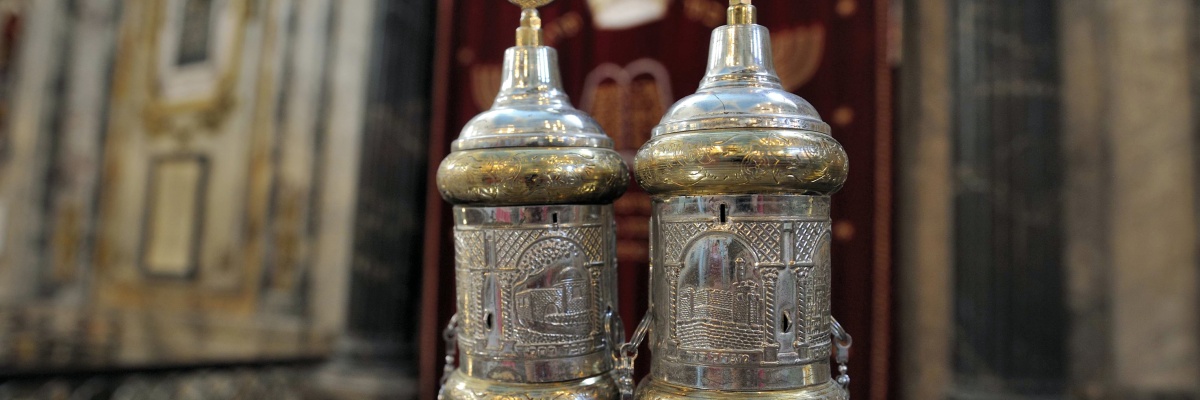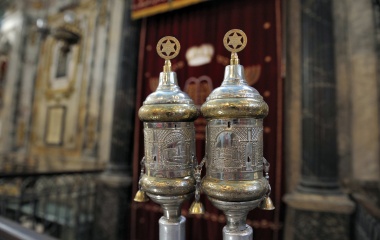
Narbonne, Lunel, Arles, Perpignan, Posquières, Montpellier are some of the great medieval centres of Jewish learning in Provence. Today there are very few, if any, Jews in many of the communities of Provence. In pretty much every medieval European country, Jews were expelled at various times, often returning a short time later, at times much later and at times never. While Jews were expelled from France in 1306, 1322 and in 1394, these expulsions did not directly impact many of the Jews of Provence. They were spared as the area of Provence did not become part of France until 1481 but rather was part of the papal states. For much of the 14th century the seat of the papacy was situated not in Italy but in Avignon, Provence and Jews who were lucky enough to live under the direct jurisdiction of the Church were spared expulsion.
While the Church believed the Jewish people were to suffer, wander, even despised, Church policy forbade the killing or even violence towards the Jew. They were the symbol of what happens to those who reject Christianity but are to be kept alive[1]. This is why Jews generally lived in the shadow of the church and/or the royal palace which offered them protection. It is for the same reason that Jews often welcomed living in the ghetto. With locked gates at night – and access to the “outside world’ in the day – the people felt protected, not to mention the religious, and social benefits of living amongst Jews. It is for this reason many Diaspora Jews today prefer to live in modern Jewish “ghettos”.
Nothing however, lasts forever and by the 16th century Jews were allowed to live only in four communities in Provence: Avignon, Carpentras, Cavaillon, and l'Isle-sur-la-Sorgue, communities from which they were never expelled. We should not be surprised to learn that in Carpentras, the siddur included a prayer for the pope.
Today there are small Jewish communities in two of the four towns of the former Papal territory.
With little Jewish infrastructure today the city of Avignon had difficulty attracting a rabbi. Their previous rabbi did not even live in the city and would come for some shabbatot and special occasions. Realizing the community would die if this continued communal leaders decided they needed a “Chabad rabbi”, knowing the lifelong commitment they bring to even the far-flung Jewish periphery.
In 2022 Rabbi Chanan Lewin, a native of Paris, and his wife Chomi, a native of Israel, left Israel to serve the community of Avignon. Soon realizing that a place with no minyan, no kosher food, no mikva – the closest one being in Marseille some 90 minutes away – and no other observant Jews they decided that it was time to leave, less than three months after they arrived. The Chabad “head office” asked that they stay for one year – but to work that year as if there is no turning back. Only at that point if they still felt there was little hope for the future could they leave. Three years later there is a minyan every Shabbat, both at night and day, along with a minyan on Mondays and Thursdays, a Hebrew school and camp for the kids. After meeting Rabbi Lewin it is clear that the community of Avignon made a very wise choice.
The beautiful and intimate shul of Avignon was originally built in the 13th century and was rebuilt on the same location in 1846 after a fire the previous year had destroyed the shul[2].
The shul in Carpentras established in 1343 and rebuilt and expanded in the mid-18th century, is the oldest shul in France in continuous use. Unfortunately, it is only used on Shabbat nowadays. We did read form the Torah there on Thursday morning using a sefer Torah some 150 years old. A visit to the basement of the shul tells us much about Jewish life in the Middle Ages. While the shul is quite beautiful it is relatively small, seating maybe 75 people at capacity. And that would be 75 men. The women were seated downstairs – in the basement – and there were small holes in the floor so the women could hear the davening.
Also in the basement is the ancient mikva with much more than 40 seah of water (the minimum quantity of water needed for a mikva – approximately 360 litres of water) still inside. And the large basement included two bakeries – with wood burning ovens – one for chametz and one for making matza. One should recall that people did not have ovens and stoves in their homes in medieval times. The halachic literature is full of discussion of keeping the cholent hot for shabbat and transporting it to local homes.
The third of the four protected communities, that of Cavaillon no longer has an active Jewish community. But it has a beautiful little shul, dating from the 15th century, also rebuilt in the 18th century, that can seat 30 people maximum – and is used today on occasion by families specifically coming to celebrate smachot. As you may have guessed, the women used to sit downstairs which was actually roomier than the men’s synagogue. Some 14 steps up from men’s section was the bimah from where the chazzan davened. As was explained to us, from this position the acoustics were such that the women sitting in the basement could hear perfectly. This custom, common in Provencal shuls is in contradistinction to the more Ashkenazic custom where based on the verse “from the depths I call out Hashem”, the chazzan would daven from a sunken spot.
Instead of the “Ten Commandments” situated on top of the Aron Kodesh as is common in most shuls, in Cavaillon, they are listed on the inside of the Aron. But that is not what makes them unique. What does so is the fact that there are actually Twelve lines[3] – six on each side. What we consider the second commandment – not to have other gods – is divided into three, do not have other gods, not to make graven images and not to bow down to them. Thus “lo tisah”, taking G-d’s name in vain is the fifth line and Shabbat the sixth. The second column begins with honouring our parents, placing it with the other five dibrot between man and man – something that makes much logical sense.
[1] Undoubtedly, the Church also understood the economic benefits of having Jews being able to engage in commerce and were loath to give up the monetary benefits they gained from the Jews.
[2] Fires were a most serious problem and caused much destruction throughout much of history (and sadly climate change is making this a major problem one again). The Jewish community of Salonika – one of the most significant Jewish communities in the world – began its decline after a major fire in 1924 destroyed many homes, shuls and other Jewish infrastructure. But this was a blessing in disguise as the many who left – to America and Israel – escaped the horrors of the Holocaust.
[3] The Torah never mentions the Ten Commandments, rather they are the Aserest Hadevarim, the Ten Statements, and in fact the Rambam and the Sefer Hachinuch following in his footsteps, actually do count the “second” of the Ten Commandments as three distinct mitzvot.

